Funny Photos of Hillbillies Mobile Home Tie Downs
Hillbilly Ingenuity: Tourism and Souvenirs
In 2008, my current hometown of Charlotte, North Carolina, hosted the Meineke Car Care Bowl at Bank of America Stadium. The opposing football teams were West Virginia University (WVU) and the University of North Carolina at Chapel Hill (UNC). Customarily, there's a lot of trash talking going on between the fans of the opposing teams in the days and hours leading up to a bowl game. But when West Virginia is involved, you can almost bet money on how it's going to go for the Mountaineers. And Tarheel fans went there.
Some wore "hillbilly teeth," a novelty item worn in the mouth to resemble rotten, crooked, and missing teeth. They made references to inbreeding and ignorance. And one North Carolina reporter wrote the following after the game: "West Virginia fans came in droves (actually they came in their homes-on-wheels)," a not-so-subtle reference to mobile homes. He might as well have written "there were several empty trailer parks in West Virginia this week."
I live in Charlotte, but I'm originally from West Virginia. I know that my relatives who still live there were very excited that WVU was in a bowl game, so the hillbilly stereotyping from UNC fans stung a bit. My aunt, who is in her seventies, even asked me: "Why do they do that to us?"
By saying "us" my aunt saw herself as part of a community of people. Mountaineers. West Virginians. I knew what she meant; still, "us" means a world of people, although in this context the term "hillbilly" refers to whites born and raised in southern Appalachia. While African Americans have also lived in the region for generations, and the Hispanic population is growing, whites are generally the object of the derogatory language and descriptors ascribed to the mountain folk called "hillbillies."
Popular culture is probably the biggest culprit for this state of affairs. Folklorist Archie Green found that the term "hillbilly" made its first print appearance in the New York Journal in 1900. According to the author "a Hill-Billie is a free and untrammelled white citizen of Alabama, who lives in the hills, has no means to speak of, dresses as he can, talks as he pleases, drinks whiskey when he gets it, and fires off his revolver as the fancy takes him." Years later, during the 1930s, the comic hillbilly appeared in the movies, in cartoons like Snuffy Smith and Li'l Abner, and on the radio, which featured acts like Lum 'n' Abner and Judy Canova. In the 1960s, rural comedies like The Beverly Hillbillies and The Andy Griffith Show, which featured the rock-throwing hillbilly Ernest T. Bass and the musical Darling family, were extremely popular. In 1972, however, the film Deliverance represented a dark turn in the popular image of hillbillies that Americans have not been able to shake since.
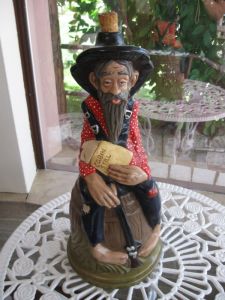
Decanter that employs the hillbilly stereotype. Photo by Karen Cox.
Still, it is the popular image of the snaggle-toothed hillbilly—the barefoot, rifle-toting, corncob pipe–smoking, moonshine-swilling man in a slouch hat—that has most contributed to the tourist industry that developed in both southern Appalachia and the Ozark Mountains (the other place where hillbillies are said to exist). Hillbilly tourist sites and souvenirs sold there have been around since the 1930s, during the early days of automobile tourism. The development of the interstate highway system contributed to its growth in the late 1950s and 1960s, and the many remnants of those hillbilly tourist attractions and souvenirs still exist.
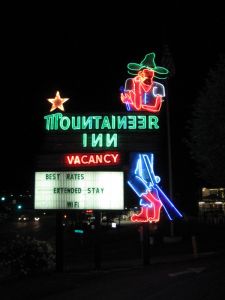
Mountaineer Inn. Photo by Karen Cox.
The Mountaineer Inn in Asheville, North Carolina, is an iconic hillbilly-themed motel that has weathered the changes in mountain tourism. Built in 1939, the inn added a neon hillbilly to its sign around 1960 and some of the original rooms have features that date to its origins—especially the cedar paneling and doors. The neon hillbilly also exhibits all of the stereotypes one associates with the mountaineer—he smokes a corncob pipe, has a rifle, wears overalls, is barefoot, and holds a jug of moonshine.
The spelling of "Mountaineer Inn" represents a common feature of hillbilly signage and can also be found on souvenirs. The "N" and the "E" are reversed, which plays into the perception of mountain people in general—that they are backward and poorly educated.
Unfinished wood, with the bark still on, and dried corncobs are frequently the material used to make hillbilly souvenirs. They purposely suggest the idea that hillbilly life is rustic. And yet, they also hint at the ingenuity of a people who've had no exposure to the outside world or modern technology.
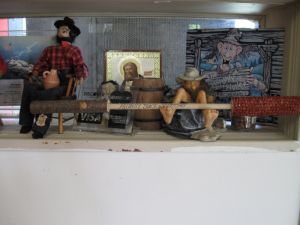
Hillbilly Back Scratcher. Photo by Karen Cox.
Inside the office of the Mountaineer Inn, for example, a "Hillbilly Back Scratcher" was on display. It had an unfinished wooden handle on one end and a small, dried corncob for scratching on the other. Over in Chimney Rock, North Carolina, I found a mallet made of wood (bark still on) that had alternative uses depending on how they were marked. The one I picked up was called a "woman getter." A version of this mallet on a much longer (and crooked) stick can be found in mountain tourist shops and for sale online as hillbilly golf clubs. The golf balls? Walnuts whose shells are painted white.
The genius, of course, are the resident entrepreneurs who have taken advantage of the popular perception of hillbillies and turned it into a lucrative business, appealing to tourists with what are often humorous souvenirs. It's sort of a tongue-in-cheek, a wink and a nod at popular culture, and a smart business move.
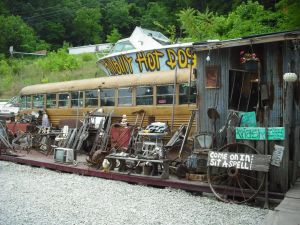
Hillbilly Hot Dogs, Lesage, WV. Photo by Karen Cox.
Back in West Virginia where many of my relatives still live, that entrepreneurial spirit exists in a restaurant called "Hillbilly Hot Dogs." The owners totally play off of the stereotypes of hillbilly culture. The menu includes the "Snuffy Dog," the "Achy Breaky Flaky Steaky," and "Bubba's Single Wide 51b Burger." It's hard to capture the visual of the place, except to say that it looks more like a junkyard. An old school bus serves as a dining car and there's a moonshine still. There's also an outhouse identified as a "Hillbilly Gas Station." The place is so popular—with tourists and locals alike—that the Food Network featured it on Diners, Drive-Ins, and Dives.
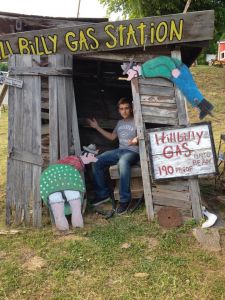
My cousin's son, Brock Thompson, at the Hillbilly Gas Station. Photo by Karen Cox.
And my aunt loves it.
So what gives? It upset her to see UNC fans disparage West Virginia during that bowl game in Charlotte, but she gets a kick out of going to Hillbilly Hot Dogs, which also plays into stereotype.
It's all a matter of intent. The best analogy I have for it is this: siblings can quarrel and make mean remarks to one another, but let an outsider make those same remarks and, well, them's fightin' words.
So, Tarheel fans crossed a line. But, as with the entrepreneurs who sell hillbilly souvenirs, West Virginia's fans had the last laugh. The final score in that bowl game? WVU 31, UNC 30.
Put that in your corncob pipe and smoke it.
Source: https://southwritlarge.com/articles/hillbilly-ingenuity-tourism-and-souvenirs/